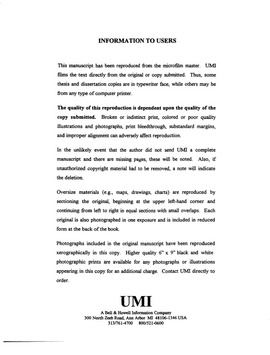| dc.contributor.advisor | Philp, R. P., | en_US |
| dc.contributor.author | Mueller, Eric. | en_US |
| dc.date.accessioned | 2013-08-16T12:30:22Z | |
| dc.date.available | 2013-08-16T12:30:22Z | |
| dc.date.issued | 1998 | en_US |
| dc.identifier.uri | https://hdl.handle.net/11244/5734 | |
| dc.description.abstract | In this study a number of source rock samples obtained from cores of wells drilled in different parts of the Green River Formation of the Uinta Basin were analyzed in order to characterize the geochemical variations associated with lacustrine organic-rich rocks. The analysis of crude oil samples from various fields in the basin was intended to document whether the variation in source rock geochemistry has a consequence on the composition of the oils produced in the basin and if these variations permit inferences about hydrocarbon generation and migration patterns. | en_US |
| dc.description.abstract | The overall results of the study demonstrate how organic geochemical data, when integrated into a stratigraphic framework, can assist the investigation of different aspects of lacustrine petroleum systems, ranging from hydrocarbon generation and migration patterns to the characterization of lake evolution through time. Relatively simple multivariate statistical evaluation of the of source rock extract and crude oil analyses greatly facilitated the interpretation and correlation of the samples. | en_US |
| dc.description.abstract | Crude oils produced in the basin inherited the stratigraphic signature of source rocks and biomarker distributions which permits detailed correlation to specific source rock sections. Apart from the waxy oils produced in the deepest reservoirs of the basin, 6 additional oils groups have been differentiated. Geographical distribution of oil types and their correlation to the source rocks permit inferences about direction and timing of hydrocarbon migration and trapping. The hydrocarbon kitchen is located in the north central part of the basin, where oils were generated from successively younger source rocks with increasing subsidence and migrated in south easterly direction into the peripheral fields of the basin. Oils from the stratigraphically oldest source rocks are produced farthest away from the kitchen. Smaller pools in the central part of the basin received charges from distinct local sources, some with contribution from hydrocarbon migrating along the main pathway. Molecular thermal maturity parameters indicate that the peak hydrocarbon generation currently is occurring in the Colton Tongue and stratigraphically equivalent marginal and open lacustrine facies in the north-central part of the basin. Basal Green River Formation source rocks in this area are in the late generation stage. In addition, it is suspected that nearshore open lacustrine source rocks in the south-central part of the basin are in the late early generation to beginning peak generation stage. Source rock samples from the Grater Red Wash area are immature and probably have not contributed significantly to hydrocarbon generation. However, immature oils, possibly generated by other mechanisms than thermal maturation, are related to the oil-shales occurring in this area. | en_US |
| dc.description.abstract | Organic matter composition and biomarker analysis of the source rocks can be related to lake evolution in the Tertiary lacustrine depositional system of the Uinta Basin, Utah. Biomarker data, integrated into a stratigraphic framework, and used as molecular fossils, provided additional information for the identification of changes in the depositional environment through time. A gradual transformation from a freshwater lacustrine system in the lower Green River Formation through a shallow water stage with fluctuating lake water chemistry is manifested in the chemical composition of the organic matter. Lean oil shale deposition also took place in a shallow, anoxic water regime and produced lithologically similar, but geochemically different source rock types than those of the mahogany zone. | en_US |
| dc.format.extent | xix, 169 leaves : | en_US |
| dc.subject | Petroleum Geology Utah Uinta Basin. | en_US |
| dc.subject | Organic geochemistry Utah Uinta Basin. | en_US |
| dc.subject | Geology. | en_US |
| dc.subject | Petrology Utah Uinta Basin. | en_US |
| dc.title | Temporal and spatial source rock variations and the consequence on crude oil composition in the Tertiary petroleum system of the Uinta Basin, Utah, United States of America. | en_US |
| dc.type | Thesis | en_US |
| dc.thesis.degree | Ph.D. | en_US |
| dc.thesis.degreeDiscipline | Conoco Phillips School of Geology and Geophysics | en_US |
| dc.note | Source: Dissertation Abstracts International, Volume: 59-11, Section: B, page: 5752. | en_US |
| dc.note | Adviser: R. P. Philp. | en_US |
| ou.identifier | (UMI)AAI9911867 | en_US |
| ou.group | Mewbourne College of Earth and Energy::Conoco Phillips School of Geology and Geophysics | |
